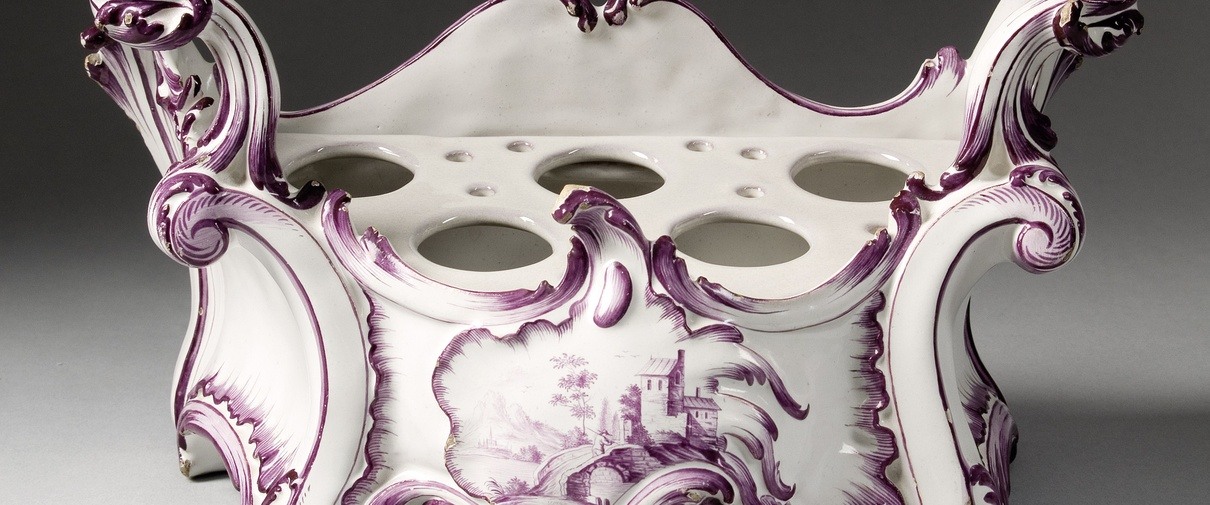Hyacinth container, approx. 1760 - 1770, earthenware, h. 15.5, on loan from Ottema Kingma Foundation.
Needless to say, his competitors were soon snapping at his heels. Between 1700 and 1720, the Haarlem growers marketed at least 100 different varieties. The hyacinth became more and more popular and the prices of the bulbs rose accordingly. At the beginning of 1729, a long period of severe frost – one could even cross the Zuiderzee by horse and sledge – caused enormous damage to the hyacinth crop. Consequently, many varieties disappeared. And perhaps that was precisely the reason why prices rose astronomically. In 1733, lovers of the Passé non plus ultra hyacinth would have had to pay between 1600 and 1850 guilders for a single bulb (although that did include the cluster of 8 baby bulbs it would produce). As had happened with tulip bulbs exactly a century earlier, prices of hyacinth bulbs skyrocketed, but this speculative madness was likewise short-lived. The bubble burst in 1735 and prices fell to more acceptable levels.
Nevertheless, the hyacinth remained one of the most popular flowers throughout the eighteenth century. A second hyacinth era followed in 1745. This was because Madame de Pompadour had picked the hyacinth as her favourite flower. The famous mistress of Louis XV was a trendsetter in all areas of fashion and what we now call ‘lifestyle’. The French king ordered many hundreds of bulbs for his mistress each year from Haarlem. A surviving invoice confirms that in 1759 he ordered ‘363 Hyacinth bulbs for (flower) beds and 200 for glasses in winter’. In addition to providing insight into the quantities of bulbs ordered, this document also reveals that at that time hyacinths were not only planted in outdoor flowerbeds but also indoors.
Rond 1710 was al bekend dat een hyacintenbol ook zonder aarde tot bloei kon komen, namelijk op een glazen vaas met onderin een laagje water. Uit de nota aan de koning blijkt dat Madame de Pompadour dergelijke It was widely known by around 1710 that a hyacinth bulb could bloom without soil in a glass vase with a layer of water in the bottom. The invoice to the king shows that Madame de Pompadour had such ‘glasses’ her disposal. After 1750, special hyacinth containers made of painted earthenware also appeared on the market. They are elegant and flamboyant, entirely in keeping with contemporary rococo taste. The hyacinth container in the Princessehof collection is a splendid example. It would certainly not have looked out of place in Madame de Pompadour’s lavish interior.
Most hyacinth containers have a separate grid – also made of earthenware – with a few large round holes for the bulbs and often some small adjacent holes to insert sticks as supports. At a certain point in their growth cycle hyacinths become top heavy and the stems can snap. Most of the containers that have been preserved lack the grid, which was most likely broken through use. This is also the case with this container. However, the previous owner had a new grid made after an historical example. And rightly so, because nowadays we buy hyacinths in plastic pots (convenience serves humanity), but doesn’t such a richly flowering and deliciously fragrant herald of spring deserve something better?
The hyacinth container
The hyacinth container is unmarked, but based on similarities in the shape and decoration of marked objects it is attributed to Johan van Kerckhoff’s factory in Arnhem. This factory only operated for a brief period, from about 1759 to 1770. For just over ten years, the company produced tableware and other utility wares and decorative objects of a high standard, in a style more in keeping with that of foreign producers than that of Delft. This international orientation is not so strange. In addition to Delft craftsmen, the Arnhem factory also employed various modellers and painters from Germany and France. They brought with them knowledge, experience and new ideas about shapes and decorations.
